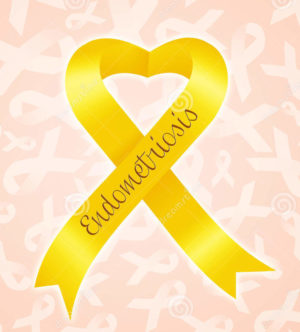March is National Endometriosis awareness month, and is dedicated to creating awareness of a disease that has been called puzzling at best.
Endometriosis is when tissue similar to that found in the uterus or womb is found in other locations in the body. These growths or implants can be found in other areas like the abdomen, intestines, bladder, reproductive organs, and sex organs. Since they build up tissue and then shed it during each menstrual cycle, they can cause bleeding, pain, scar tissue, damaged fallopian tubes, and ovaries, and other complications. Some can cause problems getting pregnant or during pregnancy. It is believed that infertility affect 30-40% of those women with Endometriosis.
Endometriosis Symptoms
- Endometriosis causes excruciating pain
- Pain that is abnormal before and during periods
- Pain during or after sexual activity
- Painful urination/bowel movements during cycles
- Fatigue
- Infertility
- Heavy bleeding
- Other gastrointestinal upsets such as diarrhea, constipation, nausea
- Allergies
- Chemical sensitivities
- Frequent yeast infections
Many women with endo also experience a range of immune disorders, including asthma, eczema, and certain autoimmune diseases.
What Causes Endometriosis?
There are many theories about what causes this puzzling hormonal and immune disease.
There are some environmental toxins, which act like hormones in the body and damage the immune system, can cause endometriosis.
There are dioxins, which readily concentrate in the food chain, contaminating animals and fish; are then transferred to humans through consumption.
There is a genetic theory suggests that certain families have predisposing factors for the disease.
There are additional theories including remnant embryonic tissue, transtubal migration theory and others that are under study.
Endometriosis Diagnosis
To be fully diagnosed with Endometriosis, a patient would undergo a laparoscopy where a fiber-optic instrument is inserted through the abdomen or pelvis to identify the location, size, and extent of the growths.
Endometriosis Treatment
Although there is no cure for endometriosis, a variety of treatment options exist.
Your specific goals may include:
- relieving/reducing pain symptoms
- shrinking or slowing endometrial growths
- preserving or restoring fertility
- preventing/delaying recurrence of the disease
Here are the current most common endometriosis treatments and coping methods available today:
PAIN MEDICATION: Over-the-counter pain relievers may include aspirin and acetaminophen, as well prostaglandin inhibitors such as ibuprofen, naproxen sodium, indomethacin, and tolfenamic acid. In some cases, prescription drugs may be required.
HORMONAL THERAPY: Hormonal treatment aims to stop ovulation for as long as possible and may include: oral contraceptives, progesterone drugs, a testosterone derivative (danazol), and GnRH agonists (gonadotropin-releasing hormone drugs).
SURGERY: Conservative surgery seeks to remove or destroy the growths, relieve pain, and may allow pregnancy to occur in some cases usually involving laparoscopy. Radical surgery, which may be necessary in severe cases, involves a hysterectomy, removal of all growths, and removal of ovaries.
ALTERNATIVE TREATMENT: Complementary endometriosis treatment options may include traditional Chinese medicine, nutritional approaches, homeopathy, allergy management, and immunotherapy.
READ MORE: Emporia Gazette: Endo What?
Note: This article is strictly for news and information about a disease or condition. It does not provide medical advice, diagnosis, or treatment. This content is not intended to be a substitute for professional medical advice, diagnosis, or treatment. Always seek the advice of your physician or other qualified health provider with any questions you may have regarding a medical condition. Never disregard professional medical advice or delay in seeking it because of something you have read on this website. The opinions expressed in this column are intended to spark discussion about issues pertaining to various health issues.

